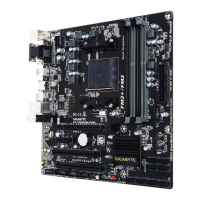
Do you have a question about the Gigabyte GA-F2A88XM-D3HP and is the answer not in the manual?
| Memory channels | Dual-channel |
|---|---|
| Memory slots type | DIMM |
| Supported memory types | DDR3-SDRAM |
| Supported memory clock speeds | 1333, 1600, 1866, 2133, 2400 MHz |
| Supported memory module capacities | 1GB, 2GB, 4GB, 8GB, 16GB, 32GB, 64GB |
| Processor socket | Socket FM2+ |
| Processor manufacturer | AMD |
| Compatible processor series | AMD Athlon |
| USB 2.0 connectors | 8 |
| Serial port headers | 1 |
| S/PDIF out connector | Yes |
| Number of Parallel ATA connectors | - |
| USB 3.2 Gen 1 (3.1 Gen 1) connectors | 4 |
| USB 3.2 Gen 2 (3.1 Gen 2) connectors | 2 |
| RAID levels | 0, 1, 5, 10, JBOD |
| Supported storage drive interfaces | SATA |
| HDMI version | 1.4 |
| USB 2.0 ports quantity | USB 2.0 ports have a data transmission speed of 480 Mbps, and are backwards compatible with USB 1.1 ports. You can connect all kinds of peripheral devices to them. |
| USB 3.2 Gen 1 (3.1 Gen 1) Type-C ports quantity | 0 |
| Ethernet interface type | Gigabit Ethernet |
| Component for | PC |
| Power source type | ATX |
| Motherboard chipset | A88X |
| Audio output channels | 7.1 channels |
| Motherboard form factor | micro ATX |
| Windows operating systems supported | Windows 10 Education x64, Windows 10 Enterprise x64, Windows 10 Home x64, Windows 10 Pro x64, Windows 7 Enterprise, Windows 7 Enterprise x64, Windows 7 Home Basic, Windows 7 Home Basic x64, Windows 7 Home Premium, Windows 7 Home Premium x64, Windows 7 Professional, Windows 7 Professional x64, Windows 7 Starter, Windows 7 Starter x64, Windows 7 Ultimate, Windows 7 Ultimate x64, Windows 8.1 Enterprise x64, Windows 8.1 Pro x64, Windows 8.1 x64 |
| Maximum resolution | 4096 x 2160 pixels |
| Maximum graphics card memory | 2000 MB |
| Number of displays supported | 3 |
| BIOS type | UEFI AMI |
| ACPI version | 5.0 |
| Bundled software | Norton® Internet Security (OEM version) |
| Depth | - mm |
|---|---|
| Width | 244 mm |
Guidelines for safe and proper installation of motherboard components to prevent damage.
Details the technical specifications of the motherboard, including CPU, memory, and expansion slots.
Step-by-step instructions for correctly installing the APU and its associated cooler.
Guide on how to correctly install DDR3 memory modules into the motherboard slots.
Procedures for installing various expansion cards into the motherboard's PCI Express or PCI slots.
Instructions for configuring AMD's Dual Graphics technology for enhanced display performance.
Identification and description of all ports and connectors located on the motherboard's back panel.
Explains the purpose and location of various internal connectors on the motherboard.
Displays the initial GIGABYTE logo screen that appears when the computer boots.
Explains how to navigate the main BIOS Setup menu using keys or mouse.
Advanced settings for CPU, memory, and system frequencies, voltages, and timings.
Provides details about the motherboard model, BIOS version, and system language settings.
Configuration options for boot priorities, security, fast boot, and CSM support.
Settings for onboard devices like USB controllers, audio, LAN, and graphics.
Options for configuring system power states, wake-up events, and energy saving features.
How to save BIOS changes, exit, load defaults, or perform boot overrides.
Steps to configure SATA controller mode (IDE, AHCI, RAID) in BIOS for storage management.
Guide on installing the necessary drivers and operating system for RAID/AHCI configurations.
Instructions for installing essential motherboard drivers and recommended software using Xpress Install.
Information on installing GIGABYTE's utility applications like APP Center and EasyTune.
Details about the drivers included on the motherboard driver disk and contact information.
Explains GIGABYTE's Q-Flash and @BIOS tools for updating the motherboard's BIOS.
Introduces GIGABYTE's utility suite for managing apps, drivers, and BIOS updates.
Utility to manage the Windows startup menu and default screen display.
Guide for setting up 2/4/5.1/7.1-channel audio, S/PDIF out, and microphone recording.
Solutions for common system startup problems and frequently asked questions.
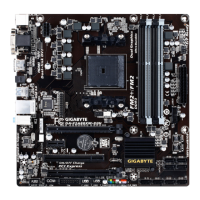

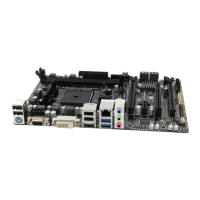
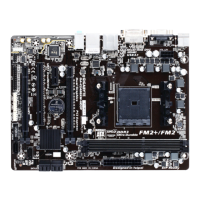





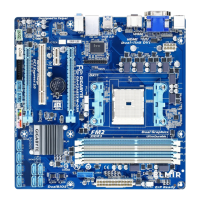
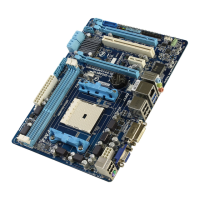
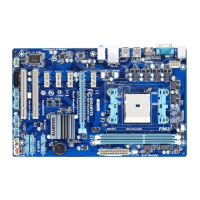
